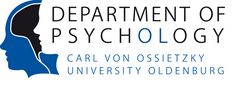Kontakt
Leitung
Geschäftsstelle
Anschrift
Combining EEG and tACS
A recently developed method of brain stimulation – referred to as transcranial alternating current stimulation or tACS – allows to modulate brain oscillations non-invasively (Herrmann et al., 2013). In order to demonstrate that brain oscillations are in fact modulated, it is desirable to record EEG.
Off-line recording of EEG
Due to the artefact that tACS introduces into EEG recordings, it is easiest to record EEG before and after tACS stimulation, i.e. off-line. We have successfully done that using DC Brain Amps with 16 bits of AD resolution. We mounted EEG as well as tACS electrodes before the experiment and recorded EEG starting before tACS and lasting until after tACS. During tACS, EEG is saturated by the tACS sine wave that can be up to 1 Volt and above and cannot be analyzed afterwards. The EEG amplifier (Brain Amp MR plus), however, is not damaged by stimulation, since it is designed to cope with the artefact introduced by MRI scanning.
- Zaehle et al., 2010:
Demonstration that 10 minutes of tACS at participants individual EEG alpha frequency elevates the amplitude of alpha oscillations for 3 minutes after the end of stimulation as compared to before stimulation. - Neuling et al., 2013:
Demonstration that 20 minutes of tACS at participants individual EEG alpha frequency elevates the amplitude of alpha oscillations for 30 minutes after the end of stimulation as compared to before stimulation. - Kasten et al., 2016:
Demonstration that 20 minutes of tACS at participants individual EEG alpha frequency elevates the amplitude of alpha oscillations for 70 minutes after the end of stimulation as compared to before stimulation. - Kasten et al., 2017:
Demonstration that elevated EEG alpha amplitudes modulate behavior in a mental rotation task.
On-line recording of EEG
Ideally, one would like to record and analyze EEG during tACS stimulation. This requires that the EEG amplifier does not go into saturation and that adequate methods are applied to remove or reduce the tACS artfefact from EEG. We have demonstrated that this is possible with the Brain Amp MR plus.
- Helfrich et al., 2014:
Demonstration that tACS modulates EEG alpha oscillations during stimulation. For this purpose, EEG was corrected with a template matching procedure and a subsequent ICA. - Vosskuhl et al., 2020:
In order to investigate multiple different algorithms to reduce the tACS artefact from EEG recordings, we have externally generated a clock signal for the synch box of a Brain Amp MR plus and made sure that the tACS sine wave was synchronized to that clock signal.
Development of new stimulation techniques
Whenever new brain stimulation techniques are developed, it is desirable to demonstrate that the stimulation modulates brain activity. The following studies are examples:
- Dowsett et al., 2016:
Using saw-tooth tACS makes removal of the linear artefact easier during stimulation. - Popp et al., 2019:
The development of ERP-aligned tACS is able to elevate the reduced P300 amplitude of adult ADHD patients (Dallmer-Zerbe et al., 2020). - Stecher et al., 2021:
For some applications, it is desirable to adjust the parameters of tACS during an experiment based on current EEG parameters. Since we are not yet able to remove the artfeact on-line and in real time, we have used an interleaved closed-loop tACS. We alternate between EEG recording and tACS stimulation and compute the frequency of participants’ EEG alpha oscillations from the EEG epochs. - von Conta et al., 2021:
Temporal interference stimulation (TIS) allows stimulation of deep cortical areas without stimulating more superficial areas more strongly. For this method, two pairs of stimulation electrodes are attached to the scalp and two high-frequency sine waves are used for stimulation, e.g. 1000 Hz and 1010 Hz. An amplitude modulated signal is then introduced in those parts of the brain where the two stimulation regions overlap. EEG spectra of simultaneously recorded EEG should show peaks only at 1000 Hz and at 1010 Hz but not at 10 Hz. This makes it possible to analyze whether EEG at 10 Hz is modulated without an artefact if and only if there are no non-linear distortions in the signal. Using a 24 bit EEG amplifier (actiChamp, Brain Products), we were able to demonstrate the absence of such non-linearities.



